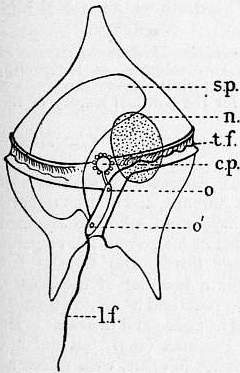|
Karlodinium Armiger
''Karlodinium armiger'' is a species of dinoflagellates belonging to the family Kareniaceae Kareniaceae is a family of dinoflagellates belonging to the order Gymnodiniales The Gymnodiniales are an order of dinoflagellates, of the class Dinophyceae. Members of the order are known as gymnodinioid or gymnodinoid (terms that can also re .... It was first isolated from the Mediterranean sea & described in 2006. It is a producer of karmitoxin, a toxin structurally related to amphidinols and karlotoxins; however karmitoxin also contains the longest carbon−carbon backbone known for this compound class, and an unusual primary amino group. It has a spherical shape with a diameter of about 15 µm. Under optimal conditions with supplemented NH4+, it has a division rate of ~0.3 times per day. References {{Taxonbar, from=Q68462532 Gymnodiniales ... [...More Info...] [...Related Items...] OR: [Wikipedia] [Google] [Baidu] |
Dinoflagellates
The dinoflagellates ( Greek δῖνος ''dinos'' "whirling" and Latin ''flagellum'' "whip, scourge") are a monophyletic group of single-celled eukaryotes constituting the phylum Dinoflagellata and are usually considered algae. Dinoflagellates are mostly marine plankton, but they also are common in freshwater habitats. Their populations vary with sea surface temperature, salinity, and depth. Many dinoflagellates are photosynthetic, but a large fraction of these are in fact mixotrophic, combining photosynthesis with ingestion of prey ( phagotrophy and myzocytosis). In terms of number of species, dinoflagellates are one of the largest groups of marine eukaryotes, although substantially smaller than diatoms. Some species are endosymbionts of marine animals and play an important part in the biology of coral reefs. Other dinoflagellates are unpigmented predators on other protozoa, and a few forms are parasitic (for example, '' Oodinium'' and '' Pfiesteria''). Some dinoflage ... [...More Info...] [...Related Items...] OR: [Wikipedia] [Google] [Baidu] |
Kareniaceae
Kareniaceae is a family of dinoflagellates belonging to the order Gymnodiniales The Gymnodiniales are an order of dinoflagellates, of the class Dinophyceae. Members of the order are known as gymnodinioid or gymnodinoid (terms that can also refer to any organism of similar morphology). They are athecate, or lacking an armor .... Genera * '' Asterodinium'' Sournia * '' Brachidinium'' Sournia * '' Gertia'' K.Takahashi et Iwataki * '' Karenia'' G.Hansen et Moestrup * '' Karlodinium'' Larsen * '' Shimiella'' Ok, Jeong, Lee et Noh * '' Takayama'' G.Hansen et Moestrup References {{Taxonbar, from=Q19941582 Gymnodiniales Dinoflagellate families ... [...More Info...] [...Related Items...] OR: [Wikipedia] [Google] [Baidu] |
Karmitoxin
Karmitoxin is an amine-containing polyhydroxy-polyene toxin isolated from ''Karlodinium armiger'' strain K-0668. It is structurally related to amphidinols, luteophanols Luteophanol is a type of organic compound. There are variants labeled luteophanol A through luteophanol D. They contain the following common fragments with amphidinols: # Polyhydroxyl groups. # Two tetrahydropyran rings. Luteophanols have demo ..., lingshuiols, carteraols, and karlotoxins. See also * Prymnesin-1 * Prymnesin-2 References Phycotoxins Polyether toxins Primary alcohols Secondary alcohols Amines Heterocyclic compounds with 1 ring Oxygen heterocycles {{Amine-stub ... [...More Info...] [...Related Items...] OR: [Wikipedia] [Google] [Baidu] |
